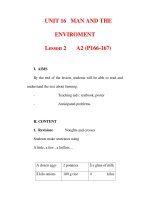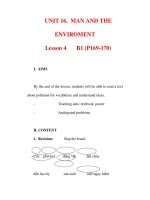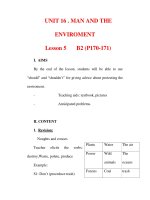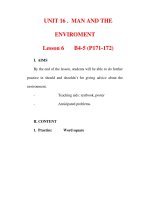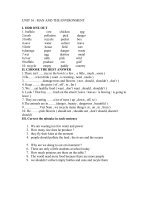4 16 NASA and the space program
Bạn đang xem bản rút gọn của tài liệu. Xem và tải ngay bản đầy đủ của tài liệu tại đây (4.61 MB, 10 trang )
Fascinating Facts
• On the Apollo 11 mission, astronauts had only
two different meals to choose from.
• More than six billion people live on Earth. Fewer
than five hundred have flown into space.
• The pump on the main engine of the space shuttle
is so powerful that it can drain a swimming pool
in twenty-five seconds.
Genre
Nonfiction
Comprehension Skill
Summarize
Text Features
• Maps
• Time Line
• Captions
• Sidebar
Scott Foresman Social Studies
ISBN 0-328-14881-4
ì<(sk$m)=bei bd< +^-Ä-U-Ä-U
Write to It!
Since 1958, the National Aeronautics and
Space Administration (NASA) has run the
United States space program. Over the years,
NASA has seen many triumphs: launching
hundreds of spacecraft to learn about other
planets, building orbiting stations where
humans can temporarily live in space, and
even putting astronauts on the moon. You will
read about the United States space program,
from its beginnings to its hopes for the future.
The exploration of space has changed
the world in countless ways. How
have NASA and the space program
affected people’s views of the world
and galaxy in which we live? How has
space exploration affected you? Write
a letter to a newspaper editor that tells
how you feel about NASA and space
exploration. Provide details about what
effects they have on you.
Vocabulary
cape
satellite
Write your letter on a separate sheet of paper.
space race
space shuttle
space station
technology
Maps
MapQuest, Inc.
Photographs
Every effort has been made to secure permission and provide appropriate credit for photographic material.
The publishe ny omission and pledges to correct errors called to its attention in subsequent editions.
Unless otherwise acknowledged, all photographs are the property of Scott Foresman, a division of Pearson Education.
Photo locators denoted as follows: Top (T), Center (C), Bottom (B), Left (L), Right (R), Background (Bkgd).
ISBN: 0-328-14881-4
Copyright © Pearson Education, Inc. All Rights Reserved. Printed in the
United States of America. This publication or parts thereof, may be used with appropriate
equipment to reproduce copies for classroom use only.
1 2 3 4 5 6 7 8 9 10 V0G1 14 13 12 11 10 09 08 07 06 05
Opener: (C) NASA, (Inset) Getty Images
4 ©NASA
6 ©NASA
Editorial Offices: Glenview, Illinois • Parsippany, New Jersey • New York, New York
10 ©NASA
12 (CR)AP/Wide World Photos,
©David Needham,
E Myers/GettyMassachusetts
Images
Sales(CL)Offices:
• Duluth, Georgia • Glenview, Illinois
13 (T) Kennedy Space Center,
(B) ©Tony
Freeman/PhotoEdit
Coppell,
Texas
• Ontario, California • Mesa, Arizona
14 ©Comstock Inc.
15 Corbis
The Military Comes to Cape Canaveral
What Is the Space Coast?
Florida has about twelve hundred miles of coastline.
Of these, most have special names given to them by
the different people who have lived in Florida over the
years. There’s the Treasure Coast, the Gold Coast, and
the Nature Coast, just to name a few. Have you ever
heard of the Space Coast? It stretches along the Atlantic
from Palm Bay to Titusville. Here you will find one of the
headquarters of the National Aeronautics and Space
Administration (NASA) at the Kennedy Space Center
(KSC). You will also find Cape Canaveral, the starting
point of America’s first voyages into space.
Welcome to Florida’s Space Coast! Fasten your seatbelts!
You are about to take a wild ride into the space age.
2
Cape Canaveral’s story as a launch site where
spacecraft takes off begins in the 1940s. The United
States military was testing rockets at a base in New
Mexico. But then a rocket went off course and crashed in
Mexico. While no one was hurt, the military decided it
needed a rocket range far from where people lived.
The military turned to Cape Canaveral. A cape is a point
of land extending out into the ocean. Cape Canaveral
offered many advantages. Few people lived in the region
and rockets could be launched over open water. The Indian
River separates Cape Canaveral from mainland Florida,
which increases privacy. The warm climate would allow the
military to launch rockets year-round.
The military took over the cape. They transformed
abandoned homes and businesses into military
buildings. They began constructing roads, runways, and
launch pads. In 1950 the United States military launched
its first rocket from Cape Canaveral.
3
Then, in 1957, all eyes turned to space. The Soviet
Union, a country that was made up of Russia and other
countries, launched a satellite to orbit Earth. Americans
were shocked that they had not produced one first. The
Soviet accomplishment spurred the Americans to build
their own satellite. Only a few months later, the United
States sent up a satellite from the cape. The space race had
begun! For the next several decades, the United States and
the Soviet Union competed over space exploration and
launched more than five thousand spacecraft.
The United States soon realized it needed one agency
to organize and carry out the space program. In
October 1958, NASA was established to develop and
launch spacecraft. It made Cape Canaveral its major
launch site.
Almost immediately, NASA began to run out of room.
Officials needed to look around for a new launching
site. They thought about Brownsville, Texas. That site was
rejected because they did not want to fly rockets over
areas where people lived. White Sands, New Mexico,
did not have any outlet to the sea. How about South Point,
a Hawaiian Island? Hawaii was too far away and a site
there would be too expensive to build.
In the end, NASA turned to a spot in its own
backyard. Merritt Island was located just north of Cape
Canaveral, across the Banana River. NASA got to
work building a first-class spaceport—a site for testing
and launching spacecraft. In 1965 the Kennedy Space
Center officially opened for business.
Cape Canaveral’s Early Years
The United States launched a
satellite in 1958. Explorer I was
its first entry in the space race.
4
Spanish explorers first visited Cape Canaveral in
1513. Canaveral means “place of the cane.” The cape
served as an important landmark for European sailors
and appeared on some of Florida’s oldest known maps.
Starting in the mid-1800s, a few American settlers and
even businesses began moving on to the cape. Over
time, small villages sprang up. But by the 1940s, the
population of the cape stood at only about 100.
5
2
1
3
1
People come to the Visitor Complex to learn about space exploration.
2
The Apollo/Saturn V Center serves as a tribute to the Apollo missions
that put astronauts on the moon.
3
Parts of the International Space System are assembled at the
International Space Station Center.
NASA’s Launch Headquarters
Today NASA launches most space voyages with crews
from the Kennedy Space Center. NASA also sends up
unmanned rockets—spacecrafts without astronauts—from
the United States Air Force Station on the cape. Though
KSC is actually located on Merritt Island, many people refer
to both the cape and the island as “Cape Canaveral.”
In addition to Cape Canaveral, NASA has nine other
field sites. The Johnson Space Center in Houston, Texas,
serves as command control. Other locations around the
country focus on research.
Let’s take a quick tour of NASA’s launch headquarters!
Millions of people from around the world come to
the Kennedy Space Center to learn about the space
program. Space shuttles are put together at the Vehicle
Assembly Building. Standing 525 feet tall with 8 acres
6
of floor space, it is one of the largest buildings in the
world. The Crawler Transporter weighs six million
pounds and travels at one mile per hour. It carries the
space shuttle from the Vehicle Assembly Building and
the launch pad. Space vehicles and missions take off
from these launch pads. Some are in use today, while
others are historic launch pads. Teams direct all launches
from the Launch Control Center. From the viewing area,
visitors to KSC can watch space shuttles lifting off from
launch pads 39A and 39B. The space shuttle lands on
the Shuttle Landing Facility as a glider. If the shuttle lands
at another NASA site, a 747 jet carries it back to KSC.
After landing, space shuttles go to the Orbiter Processing
Facilities to be inspected, tested, and repaired before
their next mission.
7
Space Programs at NASA
NASA has sent up many satellites and spacecraft from
Cape Canaveral. In 1961 NASA sent its first astronaut
into orbit around the earth. Later that year it started to
work toward a challenging goal: landing astronauts on
the moon before the decade ended. On July 17, 1969,
NASA launched Apollo 11 with three astronauts aboard.
A few days later, on July 20, the spacecraft landed on
the moon and Neil Armstrong and Edwin “Buzz” Aldrin
set foot on the moon. NASA has been the world’s only
space program to put astronauts—twelve of them in
total—on the moon.
In 1973 NASA launched Skylab, which was a
space station. For close to half a year, nine astronauts
lived and worked aboard Skylab. They gathered
information about the space environment and learned
more about the needs of humans living in space.
In 1981 NASA opened a new era in space travel with
the space shuttle program. The space shuttle is the only
reusable spacecraft. Space shuttles have wings so they
glide back to Earth at the three-mile long runway at KSC.
Astronauts aboard the space shuttle conduct experiments
and repair satellites.
The Space Race
1969
1958
The United States launches
the satellite Explorer I.
1965
1959
The Soviet Union lands
Lunar 2 on the moon.
1957
1958
1959
1960
1957
The Soviet Union launches
the satellite Sputnik 1.
8
1961
On March 18 a Soviet
astronaut leaves his
spacecraft and walks
in space.
1965
On July 20 NASA’s
Apollo 11 lands
on the moon. Neil
Armstrong and
Edwin “Buzz” Aldrin
walk on the surface
of the moon.
1969
1975
A United States spacecraft joins
together with a Soviet spacecraft. This is
the first international space flight.
1970
1972
1975
1961
1970
1972
On April 12 the Soviets send Yuri
Gagarin into space. On May 5 NASA
sends Alan Shepard into space.
The Soviets
land a
spacecraft
on Venus.
The United States launches
Pioneer 10. More than a year later,
the spacecraft flies past Jupiter. In
1983 it passes Neptune.
9
Some satellites, like the powerful Hubble Space
Telescope, are put in place by the space shuttle. Hubble
has been orbiting the earth, taking spectacular pictures
of planets and other objects in space. In 1994 it caught
images of a comet crashing into Jupiter.
Since the 1960s, NASA has also launched space
probes to explore the galaxy by taking measurements
and pictures. Sometimes the probes even land. In 2004,
rovers, or robot vehicles, sent back pictures of the
landscape of Mars, which is covered with rocks, craters,
and reddish-brown dust.
NASA scientists also use satellites to study Earth.
Satellite pictures have revealed bizarre natural activity
on the earth, some even in Florida. Images have shown
a mysterious pocket of water in Florida Bay that has
changed from bluish-green to black. Other pictures
captured “red tides” along Florida’s coast. They were
caused by dust from Africa’s Sahara Desert that traveled
all the way across the Atlantic Ocean. If you go to the
NASA Web site, you can see these images, and even
what Florida looks like from space, just the way the
astronauts see it.
10
Large pieces of the International Space Station are put together on the
ground. Other parts are put together by the crew on board.
The International Space Station
Another exciting NASA program is the International
Space Station. In the 1990s, NASA partnered with fifteen
other countries to build an international space station.
Aboard the space station, astronauts conduct many
experiments. They are working hard to learn more about
the health and safety of humans in space.
Hundreds of people on the ground contribute to the
program. If you visit the Kennedy Space Center, you can
see this amazing process take place. At the International
Space Center, some workers put the space station
together. Others test and repair equipment. Some people
partner with the space programs from other countries.
Astronauts also come to work here. They train at Johnson
Space Center in Houston, Texas—but at KSC, they try out
the actual machinery they will be using in space. Then
they blast off!
11
Over the years NASA technology has led to many
useful inventions that we use every day. Some of this
technology just makes doing things easier. But sometimes
it actually saves lives. Scientists from the Kennedy Space
Center even work with Florida’s police department to
make video footage clearer. This technology helps the
police identify criminals.
Infrared Thermometer
Taking a person’s temperature just got a bit easier. NASA first
developed a special technology to measure the temperature
of stars and planets from Earth. Now that technology
has been used to create a thermometer that
measures a person’s temperature in less than
two seconds. The person does not even have
to be awake!
Whale “Tailprints”
NASA engineers developed special software, or programs that help
computers run certain functions, to figure out how space shuttles work.
Today, marine biologists use this software to create a file for each humpback
whale they photograph. The file is based on the features of its tail. A whale’s
“tailprint” is unique, just like your fingerprints. Using this database, or
collection of files, biologists can track and identify the humpback whales.
12
Breathing System
If a fire breaks out on the launch pad, rescue
workers need to get on the job fast! So NASA
developed special equipment for emergency
rescue workers. The new air pack was lightweight
and small, so rescue workers could get into tight
places. It even helped cool the body. Today,
firefighters and other emergency workers can use
this type of air pack to save lives.
Infrared technology has proved to be a big help to
Florida in many ways. Today, the Florida Highway
Patrol uses laser guns that beam an infrared light to
catch speeding drivers. These laser guns are remarkably
accurate. Florida firefighters putting out blazes in large
buildings, such as shopping centers, also have started
taking an infrared camera along. The camera is mounted
on top of a high ladder and pointed at the building. The
pictures let firefighters see everything that is going on in
the area. Even citrus growers use this technology. Planes
carrying infrared cameras take pictures of groves. Using
special software, computers then count the trees and
identify any unhealthy ones.
Smoke Detector
NASA needed to make sure no fires broke
out on board Skylab, so scientists invented a
smoke detector. Today, most states have passed
laws that require homes to be equipped with
smoke detectors, because they have saved so
many lives.
13
Astronauts aboard
the International
Space Station are
working to answer
a question that has
been on people’s
minds for decades:
Will humans ever be
able to live on Mars?
The Future of Space
What does the future hold for the space age?
Obviously, no one knows. But NASA has lots of plans
for the future. As part of the research into settlements
on other planets some day, astronauts aboard the
International Space Station are experimenting with
growing plants in space. Plants are necessary to provide
food and oxygen. NASA has announced that it hopes to
send robots and humans to explore the moon. Aboard
a new spacecraft, called the Crew Exploration Vehicle,
NASA also wants to explore Mars—and beyond!
The Kennedy Space Center helps other communities
and countries build spaceports as well. NASA
believes that in the future, people and goods will
travel by spaceflight. NASA sees a future world in
which spaceports around the globe will launch many
spacecraft each day.
14
While you cannot look into the future and see what
the future of space exploration will hold, you can look
into the space program. Today, the Kennedy Space
Center opens its doors to millions of tourists. These
visitors welcome the chance to learn more about space
developments, examine space gear, and perhaps even
experience the thrill of seeing a spacecraft launch.
Think about this as well: Over the years, thousands of
people have settled in the towns along the Space Coast
because they want to make their contribution to NASA
and the United States’ knowledge of the galaxy. These
people combine their special skills to create the world’s
leading space program. Perhaps one day you will join
them, as an engineer, a researcher, a scientist, or even
as an astronaut!
During their training in Houston, Texas,
the crew of the space shuttle Endeavour pose together.
15
Write to It!
Since 1958, the National Aeronautics and
Glossary
Space Administration (NASA) has run the
United
the years,
cape
a States
point ofspace
land program.
extendingOver
out into
NASA
has seen many triumphs: launching
the ocean
hundreds of spacecraft to learn about other
satellite an object launched to orbit Earth or
planets, building orbiting stations where
another heavenly body
humans can temporarily live in space, and
space
race anastronauts
unofficial on
competition
even putting
the moon.between
You will
the United
States
andStates
the Soviet
to
read
about the
United
spaceUnion
program,
explore
space andtoland
on thefor
moon
from
its beginnings
its hopes
the future.
The exploration of space has changed
the world in countless ways. How
have NASA and the space program
affected people’s views of the world
and galaxy in which we live? How has
space exploration affected you? Write
a letter to a newspaper editor that tells
how you feel about NASA and space
exploration. Provide details about what
effects they have on you.
space shuttle a reusable space transportation
system that can Vocabulary
carry people and cargo
space station a human-made structure
cape
orbiting in space that people can live in for
satellite
several months
race knowledge to
technology the use space
of scientific
solve practical problems
space shuttle
space station
technology
Write your letter on a separate sheet of paper.
Maps
MapQuest, Inc.
Photographs
Every effort has been made to secure permission and provide appropriate credit for photographic material.
The publishe ny omission and pledges to correct errors called to its attention in subsequent editions.
Unless otherwise acknowledged, all photographs are the property of Scott Foresman, a division of Pearson Education.
Photo locators denoted as follows: Top (T), Center (C), Bottom (B), Left (L), Right (R), Background (Bkgd).
ISBN: 0-328-14881-4
Copyright © Pearson Education, Inc. All Rights Reserved. Printed in the
United States of America. This publication or parts thereof, may be used with appropriate
equipment to reproduce copies for classroom use only.
16
1 2 3 4 5 6 7 8 9 10 V0G1 14 13 12 11 10 09 08 07 06 05
Opener: (C) NASA, (Inset) Getty Images
4 ©NASA
6 ©NASA
10 ©NASA
12 (CR)AP/Wide World Photos, (CL) ©David E Myers/Getty Images
13 (T) Kennedy Space Center, (B) ©Tony Freeman/PhotoEdit
14 ©Comstock Inc.
15 Corbis



